|
 Suillus brevipes Suillus brevipes
SynonymsBoletus brevipes
BiostatusPresent in region - Exotic
Images (click to enlarge)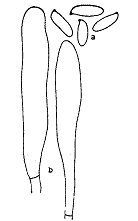
Caption: Suillus brevipes: a, spores; b, cystidia. FIG. 4—a, Suillus brevipes | 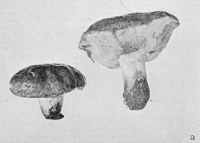
Caption: Fig. 4 - a, Suillus brevipes (x 1/2) | 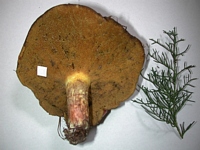
Caption: fruitbody
Owner: J.A. Cooper | 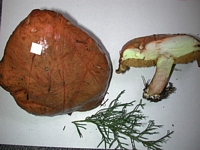
Caption: fruitbody
Owner: J.A. Cooper | 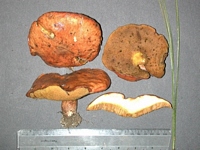
Owner: J.A. Cooper |
Article: McNabb, R.F.R. (1968). The Boletaceae of New Zealand. New Zealand Journal of Botany 6(2): 137-176 (http://www.rsnz.org/publish/abstracts.php).
Description: PILEUS: convex to plano-convex, 5-10-(14) cm diam.,
extremely mucilaginous, glabrous, evenly dark reddish brown when young, becoming
paler at maturity and dull cinnamon brown to brownish orange, occasionally with
greyish overtones imparted by the thick mucilage layer; cuticle an ixotrichodermium,
readily separable; margin entire, often irregular and extending beyond pores.
HYMENOPHORE: tubes 5-12 mm long, adnate to subdecurrent, sordid yellow when
young, becoming darker and more olivaceous at maturity; pores concolorous with
tubes, irregularly angular, 0.5-1 mm diam. STIPE: 2.5-5-(8) cm long, more or
less equal, 1.5-3 cm diam., solid, white at first, becoming pallid yellow, often
with red streaks at base; glandulae absent or occasionally a few poorly developed
glandulae visible at maturity; flesh white at first, becoming pallid yellow,
often red at extreme base: annulus absent.
SPORES: spore print
yellowish brown (between Clay Color and Buckthorn Brown); spores pallid melleous,
elliptic-subfusiform to oblong-elliptical, (6.5)-7.2 8.8-(9.8) X 2.6-3.2 µm,
smooth. HYMENIUM: basidia hyaline, clavate, 18-23 X 5-6.5 µm., 4-spored; cystidia
numerous, crowded in groups, hyaline or encrusted with brown, resinous material,
cylindrical to clavate, 35-48 X 4.5-8 µm. HYMENOPHORAL TRAMA: bilateral, of
the Boletus subtype; clamp connections absent. CONTEXT OF PILEUS: white when
young, yellow at maturity, unchanging on exposure to air. TASTE: mild. SMELL:
not distinctive. CHEMICAL REACTIONS: KOH on pileus—darkening; on context of
pileus—immediate red flush turning grey with lilac tints; NH4OH on pileus—darkening;
on context—immediate red flush turning lilac.
Habitat: HABITAT: Gregarious under Pinus.
Notes: Suillus brevipes is an introduced species typically associated with 2-and 3-needle pines
in North America. Three varieties of S. brevipes have been described,
all based primarily on colour differences and minor morphological characters
such as length of stipe. New Zealand collections agree most closely with the
type variety.
In some fruitbodies the stipe is somewhat longer than
is usual in var. brevipes. This difference is perhaps not important for,
as Smith and Thiers (1964) pointed out, the length of the stipe probably '"depends
largely on the compactness of the substratum. A possibly more significant character
is the reddish coloration at the extreme base of the stipe. This character,
which is relatively constant in New Zealand collections, was noted by Coker
and Beers (1943), but was not mentioned by Singer (1945b) and Smith and Thiers
(1964).
S. brevipes has been found only in association with Pinus radiata in New Zealand.
An interesting situation was observed at Woodhill State Forest in autumn 1966
where Suillus brevipes was fruiting abundantly under Pinus radiata,
but was absent from adjacent compartments of P. pinaster and other species.
The fruiting period of Suillus brevipes often extends well into the winter
and in 1966 and 1967 it was still fruiting when all other Suilli had disappeared.
Coker and Beers (1943) and Smith and Thiers (1964) also noted that it often
appeared late in the season. It is reported to be an edible species by North
American writers.
S. brevipes is allied to S. granulatus,
but may be distinguished by the relatively short stipe, paucity or absence of
glandulae and typically darker colour of the pileus. The range in colour of
the pileus is similar to that encountered in S. luteus. S. brevipes
has not previously been recorded from New Zealand.
Article: Gadgil, P.D. (in association with Dick, M.A.; Hood, I.A.; Pennycook, S.R.) (2005). Fungi on trees and shrubs in New Zealand. Fungi of New Zealand. Ngā Harore o Aotearoa 4: xi + 437 p. Hong Kong: Fungal Diversity Press.
Description: Type: Mycorrhizal Fungi; Description: Basidiomata pileate. Pileus evenly dark reddish brown at first, becoming cinnamon brown, 50–100 mm in diameter, convex to plano-convex, extremely mucilaginous; flesh white becoming yellow with age. Pore surface adnate to subdecurrent; tubes dirty yellow becoming olivaceous at maturity, 5–12 mm long; pores concolorous with tubes, angular, 0.5–1 mm in diameter. Stipe more or less cylindrical, white at first, becoming pale yellow later, annulus absent, 25–50 mm long. Basidiospores elliptical, 0-septate, 6–9 × 2–3 μm, smooth, pale yellow.
Distribution: Distribution: Auckland, Bay of Plenty.; 1st Record: McNabb (1968).
|